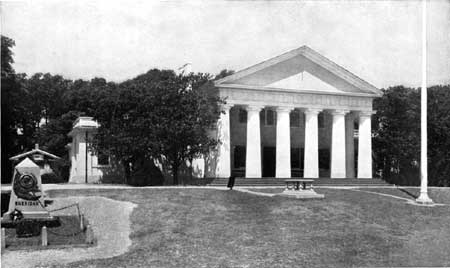MENU
|
Glimpses of Historical Areas East of the Mississippi River |
|
The Early Republic |
|
VIRGINIA |
Special Feature: Home of Robert E. Lee from 1831 to 1861.

Lee Mansion, Arlington, Va.
THE LEE MANSION, or as it is commonly known, Arlington House, distinctive through its associations with the families of Custis, Washington, and Lee, stands within the Nation's most famous cemetery on the picturesque heights of the Virginia side of the Potomac, opposite Washington. The view from the portico of the mansion embraces the Potomac, the hills of Maryland, Georgetown and Washington, and, directly below, the Memorial Bridge, beyond which stand the Lincoln Memorial, the Washington Monument, the United States Capitol, and new Government buildings along the Mall. This vista presents a panorama of architectural beauty fulfilling the vision of Pierre L'Enfant, whose tomb is located in front of the Mansion.
The Arlington estate was originally part of a grant of 6,000 acres by which Sir William Berkeley rewarded Robert Howsen, a sea captain, for aiding immigration. Sold shortly thereafter to John Alexander for six hogsheads of tobacco, it remained in the Alexander family until John Parke Custis, Washington's stepson, in 1775 purchased the estate of 1,100 acres which he named Arlington in honor of the ancestral homestead in Northampton County, Va., and of the Earl of Arlington in England. Custis' death in 1781 precluded the possibility of his building a home at Arlington. However, his son, George Washington Parke Custis, built the Arlington Mansion and occupied it after his marriage to Mary Randolph Fitzhugh in 1803.
The Mansion immediately became an active social center, representing the most romantic features of aristocratic life in the Old South. Heirlooms of the Custis and Parke families, as well as many treasured possessions of George Washington, added to its attractiveness. Lafayette, who had known Custis as a child at Mount Vernon, was once a guest at Arlington. Mary Ann Randolph Custis, the only one of the Custis children to survive infancy, and inheritor of Arlington, was married to Robert E. Lee, then a young lieutenant in the United States Army, in 1831. The marriage took place beneath the central arch in the drawing room and was followed by 5 days of elaborate festivities. The Lees resided at Arlington until the Civil War, with the exception of the period 1852-55 when Colonel Lee was superintendent of West Point.
The outbreak of the Civil War found Lee torn between devotion to his country and his native State. His decision to remain loyal to Virginia was made on April 22, 1861. The following day he left Arlington, never to return. Mrs. Lee still was engaged in the work of sending family possessions to a place of safety when the seizure of lands between Washington and Alexandria by General McDowell forced her to flee. The Washington relics found at Arlington were, upon orders from Secretary of War Stanton, stored in the Patent Office, but many other treasures were stolen or destroyed by the soldiers.
Situated on the line of fortifications guarding Washington, Arlington became an armed camp and, after the First Battle of Bull Run in July 1861, was used as a field hospital. Since the Nation's capital was a hospital center, the problem of providing suitable graves for the dead early presented itself. By 1864 the Soldiers' Home Cemetery with its 8,000 graves was filled to capacity, and immediate provision for additional space became a necessity.
The decision to make a burial ground of Arlington is said to have been made by M. C. Meigs, Quartermaster General, who, chancing to pass through the grounds while riding with Lincoln in the Presidential carriage, saw a squad of men collecting bodies from the hospital tents and carrying them out to await the arrival of the ever-tardy hearse from Soldiers' Home. Seeing the number of dead awaiting interment, Meigs ordered them buried on the spot. Sanctioned by the Secretary of War, Meigs' command led to the provision of 200 acres for cemetery purposes, and by 1870 the number of graves had reached 15,932. Five thousand of the men buried there are unknown. The War with Spain and the World War have added to the total interments, until at present 408 acres are included in the cemetery, containing approximately 43,000 graves. The amphitheatre and Tomb of the Unknown Soldier have added to the beauty and dignity of Arlington, which has been embellished by many impressive monuments.
Possession of Arlington estate might legally have reverted to George Washington Custis Lee, following the death of his mother, Mrs. Robert E. Lee, inasmuch as the United States Supreme Court had decided that the Government was a trespasser. As the easiest solution, Mr. Lee sold his rights to the United States for $150,000, relinquishing all claims.
In 1925 the Mansion, by congressional enactment, was set aside as the Lee Mansion National Memorial with the purpose of restoring the house to its antebellum condition. In 1933 jurisdiction passed from the War Department to the Department of the Interior, and it is now administered by the National Park Service.
 Top
Top
Last Modified: Thurs, Nov 23 2000 10:00:00 pm PDT
http://www.cr.nps.gov/history/online_books/glimpses3/glimpses3h.htm
![]()
